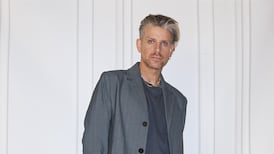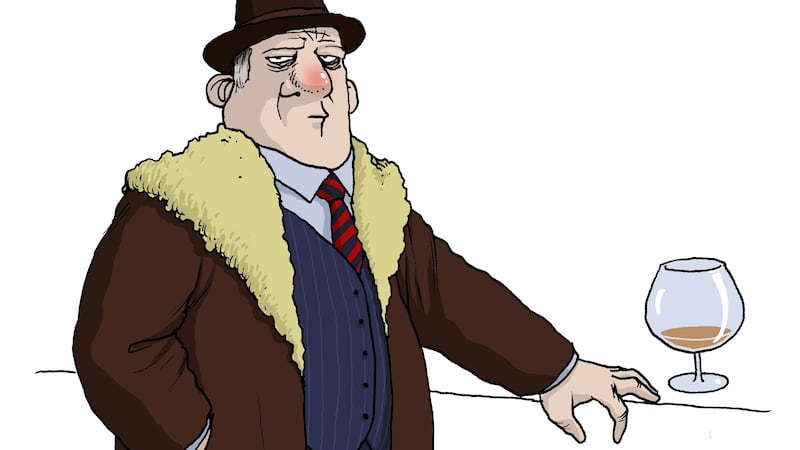One morning in the early years I was pushing my bicycle up the bog road beneath Mweelrea to foot some more of our turf. It was a most unprepossessing day, cloud clinging to the mountain like fungus and an east wind pressing down from the ridge. There was nobody else in view, and as I plodded past the turf ricks I was asking myself – perhaps not unnaturally – if I was happy.
And I decided that I must be, because I wasn’t looking forward to anything, and also that I had better be, because nothing much more wonderful was likely to happen. These were unfamiliar thoughts to one who had spent too much of his life longing vaguely for the evening, the weekend, the holiday, the letter in the post. Now I had no excuses, no postponement of happiness, for the future had arrived. After 38 years of Another Life, as I think my wife, Ethna, and our daughter, Michele, would agree, most of it turned out fine.
We both had good careers in the national media. In our 40s, what possessed us to sell up and move west to a half-converted Land Commission cottage on a bare, thistly acre above the sea? Passing the time in the car on those endless journeys home from weekends we can’t have been so different from any other Dublin couple with a holiday house on its own patch of land and a growing disillusion with city life. But somewhere in that deadening procession through Longford, Enfield, Kilcock, Maynooth, “a pity we can’t live there” became “I wonder could we?” and a list of all the things we might do once our time was our own.
Left to myself, as a closet romantic, the mere hunger for the wild and beautiful and making my days my own would not have taken me very far. But Ethna’s instinct is for solving problems, for systems and making things happen. One after another, the carborne fantasies were costed and the dreams set on schedules; that we might actually do it became, at first, rather terrifying, then the biggest adventure of our lives. In one surreal conclusion, Ethna drove us across to Mayo at a steady 40km/h, with three buzzing hives in the trailer and a few loose bees trying to keep up.
RM Block
The beekeeping bit was borrowed from her childhood on a Cavan hillside: her mother had kept hives along with turkeys and hens. From my own youth, on the outskirts of Brighton in Sussex, came a love of wildflowers and a carpenter father who, in the war years, grew food and his own tobacco and mended our clothes and shoes. When the hole for a septic tank was being dug beside our cottage in Thallabawn, the sight of deep, loamy soil must have touched something in my genes.
In the 1970s, the idea of “alternative” living was already in full vigour. In the United States, reaction to the Vietnam War had meshed with hippiedom and the green philosophy of “deep ecology” to nourish a wave of experiment in self-sufficient rural living. In Britain, it made a guru of John Seymour, author of The Fat of the Land and Self-Sufficiency. In Ireland, the move to organic growing and the disciplined methods of permaculture (these from Australia) have led today to such projects as the Cloughjordan “ecovillage” in Co Tipperary. In 1977, these ideas were still at least eccentric, and if, as some suggested, we were “living out other people’s dreams”, one still had to guess what these might be.
We were never brave enough for hippiedom (Ethna cuts my hair short, the way I like it). And our progress towards a limited self-sufficiency met several errors of design. The currach we built, for example, for the two of us to fish, scarcely felt the sea, though I kept it tarred and lashed down for many seasons in its rocky niche beyond the strand: it needed a calm day and three strong men to lift and launch it. What worked instead was a spillet – a long line of baite
On the acre, the big, costly rotovator, meant to do all the digging as it whirled away in the soil, left me deafened and exhausted and was also abandoned. I learned to wield the slim, dished spade of the west, the sharpening and magical rhythm of a scythe, the lift and flick of the sléan – all for the daily mix of muscle and brain that I thought should satisfy my soul. At the kitchen window, Ethna washed, chopped, blanched and freezered as the muddy vegetables flowed in.
[ Irish Times writer Michael Viney dies aged 90Opens in new window ]
Our daughter Michele, meanwhile, from eight onwards, had to cope with schoolyard suspicion of a red-headed outsider whose father might write anything in the newspaper. Our own townland was then sparsely peopled, the houses strung out between us and the mountain; the schoolbus had few stops on the last few miles of the road. We bought Michele a Connemara pony for the challenge and for love. I fetched him bales of hay on the bicycle trailer after our car sat down, and would linger at the stable door at dusk, breathing his warm air, nose to nose.
Our years with livestock were some of the richest of all. Ethna had initially drawn the line at goats, but ended up making cheese, along with home-baked bread and many gallons of fruit and flower wine. I did the milking, often by torchlight in the shed beside the stream that ran through a corner of the acre, communing with a matronly white Saanen as I coaxed the jet into the bucket. That special squeeze had to be learned. So did the fact that goats (like the geese, and I loved them, too) needed too much grazing space on a single, crowded acre. A dairy must also have kids, whose little horns, the book said, could be disbudded with a heated screwdriver – a day we ended up tipsy on our elderflower wine.
[ Michael Viney’s first article for The Irish Times: The man in the cottageOpens in new window ]
The “simple” life is far from that, even with expert books to advise on everything, and is sometimes fraught with clumsy, abhorrent violence. Ducklings for eating have their necks wrung at 10 weeks (those silky white wings trembling under my arm – just the once!), hens when they get sick or old, and a Christmas goose might need a hatchet. The big, flapping thornback rays, caught on the spillet, were killed and butchered on the strand. I won’t go on: the supermarket spares us such petty murders.
The demanding daily rounds of activity, played out in the appalling weather of the 1980s, sealed us off from national hardship in the world beyond the hill – that, after all, was part of the philosophy. But too many cold, drenching summers and Ethna’s sudden, unexpected allergy to beestings brought an eventual end to the hives. The goats and geese had gone, and as rural predators – fox, dog, otter, stoat, hedgehog – repeatedly culled our ducks and hens, the will to restock them diminished. Michele went off to college, so Báinin disappeared to thrill another 10-year-old in Connemara.
The acre was still growing ample food within its maze of windbreak fences and fuchsia hedges, but was now very quiet. I was free to join David Cabot, our ornithologist friend across the lake, in two expeditions to east Greenland, while Ethna took over the garden and the story of Another Life.
What has happened to our local landscape? Gone are fields of oats and the ridges of potatoes beside every house
The expeditions were to study and film barnacle geese. A few thousand of them winter on the Connacht islands but breed on the Greenland cliffs. The High Arctic wilderness leaves nature in sole possession of the raw and virgin landscape, so that everything that moved – musk oxen, snowy hares, a wandering wolf, polar bears on the fiord – was in command of a life quite indifferent to the human species. I returned to Mayo, its lush and jumbled vegetation, teeming with a range of species, with an extra feeling for our need to know more about them.
Curiosity, always my driving force, partners an aesthetic sense alive to form and colour: the wide theatre of sky and sea, the detail of plants and wildlife. The poet Michael Longley, long our friend and summer neighbour in this landscape, has described how, at first, the hugeness of its space and horizons draw the eye, then the intricate middle distance of little fields and drystone walls. “Finally, you end up on your hands and knees, almost at prayer, looking at the faces of flowers.”
It is this kind of awe that I have tried to temper with scientific fact, scouring the indexes of thousands of books on our walls and exploring current research through wireless broadband beaming in from the islands to our gable. For years of Another Life (years of carbon paper, Tippex and scrunched-up sheets of paper) my copy and drawing was sent by post – three miles each way on the bike, often in strong headwinds and horizontal rain. Now, ours is an electronic cottage, of downloads, images and emails.
The wider world has changed, too, as ecology has seized the attention of Earth’s most destructive species. Relations with the rest of life, its ecosystems and biodiversity, have taken on quite a new reality and respect. A steady flow of popular books on Ireland’s wildflowers, animals, birds and sea life has matched the rise of national expertise and a growing role for the natural world in the school experience of the young. Mine has been the marginal contribution of an inquisitive and fond interpreter, not a “naturalist”. That title is more properly reserved for those whose lifetime passions for observing and researching add to the scientific knowledge of nature, often without any material reward.
This is the close of a great adventure in living, with the partner of 50 years who has helped make so much of it happen
Meanwhile, what has happened to our local landscape? Gone are fields of oats and the ridges of potatoes beside every house. Gone are silage meitheals with their big farmhouse dinners, and the spring exodus of families to cut turf on the mountain. Gone are donkeys with “slippers” of untrimmed hooves lest they sink, and cattle grazing the “long acre” of the roadsides. Stony roads have been tarred, and the wonderful, babbling ford where the boreen crossed the mountain river (dipper, wagtails, sand martins) is culverted to link with the new car park behind the strand. More holiday homes line the brow of the hill, but the boom years expired in good time to save the view, and the men who did the building are back in good homes of their own. As the promise of farming revives, for every pasture drifting into rushes, another is cleared and resown.
For many of the early years, Another Life in The Irish Times provided virtually our sole income – this from a classically chance encounter on Dublin’s Grafton Street on the eve of our departure to the west. “You won’t be back in six months?” asked Douglas Gageby quizzically – then made his generous invitation to write a column. We had other portable skills besides, gained in television experience. As our livestock later dwindled and with our daughter launched on her own career in the film industry, Ethna and I began making documentaries for RTÉ and TnaG (TG4). They paid for a new roof, double-glazing, a new car and rare foreign holidays with friends. But really, living in our landscape, who would want to be anywhere else?
On the acre, the trees we planted so randomly whenever a seedling came to hand have grown to an awesome maturity, each bracing the other in ocean storms. They have enveloped the old plywood henhouse and its rampant fuchsia hedges, and now crowd in upon the glade where my big polytunnel shudders in the gusts, but holds. It is my all-weather palace, with earphones for music and a comfortable director’s chair.
[ Michael Viney’s final Another Life column – more than 60 years after the firstOpens in new window ]
Filling it with many kinds of vegetables is pretty much all I can manage now. This is the close of a great adventure in living, with the partner of 50 years who has helped make so much of it happen. Decades of often strenuous activity in pure ocean air, and a diet of fresh vegetables and fish, would, you might think, have guaranteed an exceptionally fit old age. They have certainly helped me survive some drastic repercussions from the heavy smoking of my city newspaper years (you want to see my scars?). At 82, their legacy now limits my energy, but still, irreducibly, I enjoy helping things to grow, walking in the wind and listening to the birds, and writing about nature as long as The Irish Times has room.
Thallabawn, Co Mayo
This article originally appeared in Michael Viney: Reflections on Another Life, published by Irish Times Books in 2015



















